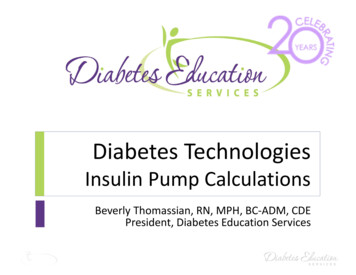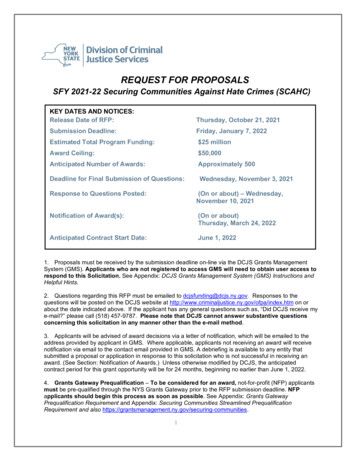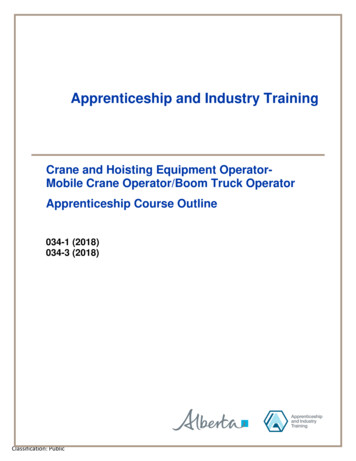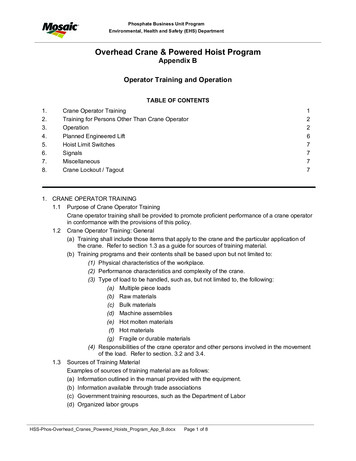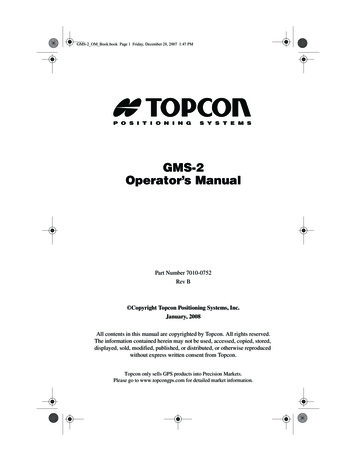
Transcription
GMS-2 OM Book.book Page 1 Friday, December 28, 2007 1:47 PMP O S I T I O N I N GS Y S T E M SGMS-2Operator’s ManualPart Number 7010-0752Rev B Copyright Topcon Positioning Systems, Inc.January, 2008All contents in this manual are copyrighted by Topcon. All rights reserved.The information contained herein may not be used, accessed, copied, stored,displayed, sold, modified, published, or distributed, or otherwise reproducedwithout express written consent from Topcon.Topcon only sells GPS products into Precision Markets.Please go to www.topcongps.com for detailed market information.
GMS-2 OM Book.book Page 2 Friday, December 28, 2007 1:47 PMECO#3198
GMS-2 OM Book.book Page i Friday, December 28, 2007 1:47 PMTOCTable of ContentsChapter 1Introduction . 1-1Principles of Operation .GNSS Overview .Calculating Absolute Positions .Calculating Differential Positions .Essential Components for Quality Surveying .Conclusion .GMS-2 Overview .Getting Acquainted with the GMS-2 .Rechargeable and Backup Batteries .GMS-2 Front .GMS-2 Back .GMS-2 Ports .SD Card Slot .Integrated Camera .External GPS Antenna Connector .System Cables .GMS-2 Software .Optional Accessories .Option Authorization File (OAF) 21-121-131-141-16Chapter 2Preparing the GMS-2 for Use . 2-1Attaching the Hand Strap .Powering the GMS-2 .Charging the Battery .Charging and Battery Storage Notes .Installing the Battery .Replacing the Backup Battery .Starting the GMS-2 .P/N 7010-07522-12-22-22-42-42-52-7i
GMS-2 OM Book.book Page ii Friday, December 28, 2007 1:47 PMTable of ContentsInstalling Software . 2-8Installing an Optional SD Card . 2-9Chapter 3Using the GMS-2 . 3-1Connecting the GMS-2 with Other Devices .Connecting the GMS-2 and a Computer .Connecting the GMS-2 and a Bluetooth Device .Surveying with the GMS-2 (Using GMS Tools) .Surveying with the GMS-2 .Surveying with the GMS-2 and an External AntennaSurveying with the GMS-2 and a Beacon Receiver .Surveying with the GMS-2 and an ExternalGPS Receiver .Backing up Windows CE RAM Data .3-13-23-33-53-53-63-73-83-9Chapter 4Using the Camera and Compass . 4-1GMS Tools .Getting Acquainted .Working with GMS Tools .Using the Camera .Using the Compass .Viewing GNSS Information and Logging Data .Keeping Internal GNSS Power On .Clearing the NVRAM .4-14-14-34-34-54-74-84-9Chapter 5Using the Bluetooth Manager . 5-1Getting Started .Getting Acquainted .Working with Bluetooth Manager .Discovering Devices .Adding to the List of Favorite Devices .Viewing Device Properties .Deleting a Device from the List .Setting Device Preferences .Pairing Bluetooth Devices .ii5-15-25-55-65-85-105-115-115-13GMS-2 Operator’s Manual
GMS-2 OM Book.book Page iii Friday, December 28, 2007 1:47 PMTable of ContentsChapter 6Troubleshooting . 6-1Check This First! .Troubleshooting Quick List .Resetting the Software .Restoring Bluetooth Module Defaults .Resetting the Hardware .Charging/Powering Problems .GMS-2 Problems .Bluetooth Problems .Obtaining Technical Support .Phone .E-mail .Website .6-16-26-36-36-46-56-56-66-86-86-96-10Appendix ASpecifications . A-1GMS-2 Specifications .General Details .GPS Details .Connector Specifications .Serial Connector .USB Connector .A-2A-2A-5A-6A-6A-7Appendix BSafety Warnings . B-1General Warnings . B-1Battery Pack Warnings . B-1Usage Warnings . B-2Appendix CRegulatory Information . C-1FCC Compliance .Canadian Emission Labeling Requirements .Community of Europe Compliance .WEEE Directive .P/N 7010-0752C-1C-2C-2C-3iii
GMS-2 OM Book.book Page iv Friday, December 28, 2007 1:47 PMTable of ContentsAppendix DWarranty Terms . D-1ivGMS-2 Operator’s Manual
GMS-2 OM Book.book Page v Friday, December 28, 2007 1:47 PMPrefacePrefaceThank you for purchasing this Topcon product. The materialsavailable in this Manual (the “Manual”) have been prepared byTopcon Positioning Systems, Inc. (“TPS”) for owners of Topconproducts, and are designed to assist owners with the use of thereceiver and its use is subject to these terms and conditions (the“Terms and Conditions”).NOTICEPlease read these Terms and Conditions carefully.Terms and ConditionsUSE This product is designed to be used by a professional. The usershould have a good knowledge of the safe use of the product andimplement the types of safety procedures recommended by the localgovernment protection agency for both private use and commercialjob sites.COPYRIGHT All information contained in this Manual is theintellectual property of, and copyrighted material of TPS. All rightsare reserved. You may not use, access, copy, store, display, createderivative works of, sell, modify, publish, distribute, or allow anythird party access to, any graphics, content, information or data in thisManual without TPS’ express written consent and may only use suchinformation for the care and operation of your receiver. Theinformation and data in this Manual are a valuable asset of TPS andare developed by the expenditure of considerable work, time andmoney, and are the result of original selection, coordination andarrangement by TPS.P/N 7010-0752v
GMS-2 OM Book.book Page vi Friday, December 28, 2007 1:47 PMPrefaceTRADEMARKS GMS-2, GMS Tools, BTManager, TopSURV,TopPAD, HiPer, Topcon and Topcon Positioning Systems aretrademarks or registered trademarks of TPS. Microsoft, Windows,ActiveSync, and the Windows logo are either trademarks or registeredtrademarks of Microsoft Corporation in the United States and/or othercountries. The Bluetooth word mark and logos are owned byBluetooth SIG, Inc. and any use of such marks by Topcon PositioningSystems, Inc. is used under license. Other product and companynames mentioned herein may be trademarks of their respectiveowners.DISCLAIMER OF WARRANTY EXCEPT FOR ANYWARRANTIES IN AN APPENDIX OR A WARRANTY CARDACCOMPANYING THE PRODUCT, THIS MANUAL AND THERECEIVER ARE PROVIDED “AS-IS.” THERE ARE NO OTHERWARRANTIES. TPS DISCLAIMS ANY IMPLIED WARRANTYOF MERCHANTABILITY OR FITNESS FOR ANY PARTICULARUSE OR PURPOSE. TPS AND ITS DISTRIBUTORS SHALL NOTBE LIABLE FOR TECHNICAL OR EDITORIAL ERRORS OROMISSIONS CONTAINED HEREIN; NOR FOR INCIDENTAL ORCONSEQUENTIAL DAMAGES RESULTING FROM THEFURNISHING, PERFORMANCE OR USE OF THIS MATERIALOR THE RECEIVER. SUCH DISCLAIMED DAMAGESINCLUDE BUT ARE NOT LIMITED TO LOSS OF TIME, LOSSOR DESTRUCTION OF DATA, LOSS OF PROFIT, SAVINGS ORREVENUE, OR LOSS OF THE PRODUCT’S USE. IN ADDITIONTPS IS NOT RESPONSIBLE OR LIABLE FOR DAMAGES ORCOSTS INCURRED IN CONNECTION WITH OBTAININGSUBSTITUTE PRODUCTS OR SOFTWARE, CLAIMS BYOTHERS, INCONVENIENCE, OR ANY OTHER COSTS. IN ANYEVENT, TPS SHALL HAVE NO LIABILITY FOR DAMAGES OROTHERWISE TO YOU OR ANY OTHER PERSON OR ENTITYIN EXCESS OF THE PURCHASE PRICE FOR THE RECEIVER.LICENSE AGREEMENT Use of any computer programs or softwaresupplied by TPS or downloaded from a TPS website (the “Software”)in connection with the receiver constitutes acceptance of these Termsand Conditions in this Manual and an agreement to abide by theseTerms and Conditions. The user is granted a personal, non-exclusive,viGMS-2 Operator’s Manual
GMS-2 OM Book.book Page vii Friday, December 28, 2007 1:47 PMTerms and Conditionsnon-transferable license to use such Software under the terms statedherein and in any case only with a single receiver or single computer.You may not assign or transfer the Software or this license withoutthe express written consent of TPS. This license is effective untilterminated. You may terminate the license at any time by destroyingthe Software and Manual. TPS may terminate the license if you fail tocomply with any of the Terms or Conditions. You agree to destroy theSoftware and manual upon termination of your use of the receiver. Allownership, copyright and other intellectual property rights in and tothe Software belong to TPS. If these license terms are not acceptable,return any unused software and manual.CONFIDENTIALITY This Manual, its contents and the Software(collectively, the “Confidential Information”) are the confidential andproprietary information of TPS. You agree to treat TPS’ ConfidentialInformation with a degree of care no less stringent that the degree ofcare you would use in safeguarding your own most valuable tradesecrets. Nothing in this paragraph shall restrict you from disclosingConfidential Information to your employees as may be necessary orappropriate to operate or care for the receiver. Such employees mustalso keep the Confidentiality Information confidential. In the event youbecome legally compelled to disclose any of the ConfidentialInformation, you shall give TPS immediate notice so that it may seek aprotective order or other appropriate remedy.WEBSITE; OTHER STATEMENTS No statement contained at theTPS website (or any other website) or in any other advertisements orTPS literature or made by an employee or independent contractor ofTPS modifies these Terms and Conditions (including the Softwarelicense, warranty and limitation of liability).SAFETY Improper use of the receiver can lead to injury to persons orproperty and/or malfunction of the product. The receiver should onlybe repaired by authorized TPS warranty service centers. Users shouldreview and heed the safety warnings in an Appendix.P/N 7010-0752vii
GMS-2 OM Book.book Page viii Friday, December 28, 2007 1:47 PMPrefaceMISCELLANEOUS The above Terms and Conditions may beamended, modified, superseded, or canceled, at any time by TPS. Theabove Terms and Conditions will be governed by, and construed inaccordance with, the laws of the State of California, without referenceto conflict of laws.Manual ConventionsThis manual uses the following conventions:ExampleDescriptionFile iiClick the File menu and click Exit.Indicates the name of a dialog box or screen.Indicates a field on a dialog box or screen, or a tabwithin a dialog box or screen.Press or click the button or key labeled Enter.Further information to note about the configuration,maintenance, or setup of a system.Supplementary information that can help youconfigure, maintain, or set up a system.Supplementary information that can have an affecton system operation, system performance,measurements, or personal safety.Notification that an action has the potential toadversely affect system operation, systemperformance, data integrity, or personal health.GMS-2 Operator’s Manual
GMS-2 OM Book.book Page ix Friday, December 28, 2007 1:47 PMManual ConventionsWARNINGDANGERP/N 7010-0752Notification that an action will result in systemdamage, loss of data, loss of warranty, or personalinjury.Under no circumstances should this action beperformed.ix
GMS-2 OM Book.book Page x Friday, December 28, 2007 1:47 PMPrefaceNotes:xGMS-2 Operator’s Manual
GMS-2 OM Book.book Page 1 Friday, December 28, 2007 1:47 PMChapter 1IntroductionThe GMS-2 receiver is a single-frequency, GPS GLONASS L1receiver and hand-held controller built to be the most advanced,compact, and portable receiver for the GIS surveying market. Anintegrated electronic compass and digital camera make the GMS-2 anall-purpose, GIS field mapping unit.The GMS-2 receiver is a multi-function, multi-purpose receiverintended for precision markets. Precision markets means markets forequipment, subsystems, components and software for surveying,construction, commercial mapping, civil engineering, precisionagriculture and land-based construction and agriculture machinecontrol, photogrammetry mapping, hydrographic and any usereasonably related to the foregoing.The GMS-2 provides the functionality, accuracy, availability, andintegrity needed for fast and easy data collection.Figure 1-1. GMS-2P/N 7010-07521-1
GMS-2 OM Book.book Page 2 Friday, December 28, 2007 1:47 PMIntroductionPrinciples of OperationSurveying with the right GPS receiver can provide users accurate andprecise positioning, a requirement for any surveying project.This section gives an overview of existing and proposed GlobalNavigation Satellite Systems (GNSS) and receiver functions to helpyou understand and apply basic operating principles, allowing you toget the most out of your receiver.GNSS OverviewCurrently, the following three global navigation satellite systems(GNSS) offer line-of-site radio navigation and positioning, velocity,and time services on a global, all-weather, 24-hour scale to any userequipped with a GNSS tracking receiver on or near the Earth’ssurface: GPS – the Global Positioning System maintained and operated bythe United States Department of Defense. For information on thestatus of this system, visit the US Naval Observatory website(http://tycho.usno.navy.mil/) or the US Coast Guard website(http://www.navcen.uscg.gov/). GLONASS – the Global Navigation Satellite System maintainedand operated by the Russian Federation Ministry of Defense. Forinformation on the status of this system, visit the Ministry ofDefense website (http://www.glonass-center.ru/frame e.html). GALILEO – an upcoming global positioning system maintainedand operated by Galileo Industries, a joint venture of severalEuropean space agencies working closely with the EuropeanSpace Agency. Unlike GPS and GLONASS, this is a civilendeavor and is currently in the development and validationstage. For information on the status of this system, visit theGalileo Industries website (http://www.galileo-industries.net).1-2GMS-2 Operator’s Manual
GMS-2 OM Book.book Page 3 Friday, December 28, 2007 1:47 PMPrinciples of OperationDespite numerous technical differences in the implementation ofthese systems, satellite positioning systems have three essentialcomponents: Space – GPS, GLONASS, and GALILEO satellites orbitapproximately 12,000 nautical miles above Earth and areequipped with a clock and radio. These satellites broadcast digitalinformation (ephemerides, almanacs, time&frequencycorrections, etc.). Control – Ground stations located around the Earth that monitorthe satellites and upload data, including clock corrections andnew ephemerides (satellite positions as a function of time), toensure the satellites transmit data properly. User – The community and military that use GNSS receivers andthe corresponding satellites to calculate positions.Calculating Absolute PositionsWhen calculating an absolute position, a stationary or movingreceiver determines its three-dimensional position with respect to theorigin of an Earth-Center Earth-Fixed coordinate system. To calculatethis position, the receiver measures the distance (called pseudoranges) between it and at least four satellites. The measured pseudoranges are corrected for clock differences (receiver and satellites) andsignal propagation delays due to atmospheric effects. The positions ofthe satellites are computed from the ephemeris data transmitted to thereceiver in navigation messages. When using a single satellite system,the minimum number of satellites needed to compute a position isfour. In a mixed satellite scenario (GPS, GLONASS, GALILEO), thereceiver must lock onto at least five satellites to obtain an absoluteposition.To provide fault tolerance using only GPS or only GLONASS, thereceiver must lock onto a fifth satellite. Six satellites will providefault tolerance in mixed scenarios.P/N 7010-07521-3
GMS-2 OM Book.book Page 4 Friday, December 28, 2007 1:47 PMIntroductionCalculating Differential PositionsDGPS, or Differential GPS, typically uses the measurements fromtwo or more remote receivers to calculate the difference (corrections)between measurements, thus providing more accurate positionsolutions.With DGPS, one receiver is placed at a known, surveyed location andis referred to as the reference receiver or base station. Anotherreceiver is placed at an unknown, location and is referred to as theremote receiver or rover. The reference station collects the rangemeasurements from each GPS satellite in view and forms thedifferences (corrections) between the calculated distance to thesatellites and the measured pseudo-ranges to the satellites.These corrections are then built up to the industry standard (RTCM orvarious proprietary standards) established for transmitting differentialcorrections and broadcast to the remote receiver(s) using a datacommunication link. The remote receiver applies the transmittedDGPS corrections to its range measurements of the same satellites.Using this technique, the spatially correlated errors—such as satelliteorbital errors, ionospheric errors, and tropospheric errors—can besignificantly reduced, thus improving the position solution accuracyof the GPS.A number of differential positioning implementations exist, includingpost-processing surveying, real-time kinematic surveying, maritimeradio beacons, geostationary satellites (as with the OmniSTARservice), and the wide area augmentation system (WAAS) service.The real-time kinematic (RTK) method is the most precise method ofreal-time surveying. RTK requires at least two receivers collectingnavigation data and communication data link between the receivers.One of the receivers is usually at a known location (Base) and theother is at an unknown location (Rover). The Base receiver collectscarrier phase measurements, generates RTK corrections, and sendsthis data to the Rover receiver. The Rover processes this transmitteddata with its own carrier phase observations to compute its relativeposition with high accuracy, achieving an RTK accuracy of up to 1 cmhorizontal and 1.5 cm vertical.1-4GMS-2 Operator’s Manual
GMS-2 OM Book.book Page 5 Friday, December 28, 2007 1:47 PMPrinciples of OperationEssential Components for Quality SurveyingAchieving quality position results requires the following elements: Accuracy – The accuracy of a position primarily depends uponthe satellite geometry (Geometric Dilution of Precision, orGDOP) and the measurement (ranging) errors.– Differential positioning (DGPS and RTK) strongly mitigatesatmospheric and orbital errors, and counteracts SelectiveAvailability (SA) signals the US Department of Defensetransmits with GPS signals.– The more satellites in view, the stronger the signal, the lowerthe DOP number, the higher positioning accuracy. Availability – The availability of satellites affects the calculationof valid positions. The more visible satellites available, the morevalid and accurate the position. Natural and man-made objectscan block, interrupt, and distort signals, lowering the number ofavailable satellites and adversely affecting signal reception. Integrity – Fault tolerance allows a position to have greaterintegrity, increasing accuracy. Several factors combine to providefault tolerance, including:– Receiver Autonomous Integrity Monitoring (RAIM) detectsfaulty GPS and GLONASS satellites and removes them fromthe position calculation.– Five or more visible satellites for only GPS or onlyGLONASS; six or more satellites for mixed scenarios.– Wide Area Augmentation Systems (WAAS, EGNOS, etc.)creates and transmit, along with DGPS corrections, dataintegrity information (for example, satellite health warnings).– Current ephemerides and almanacs.ConclusionThis overview simply outlines the basics of satellite positioning. Formore detailed information, visit the TPS website.P/N 7010-07521-5
GMS-2 OM Book.book Page 6 Friday, December 28, 2007 1:47 PMIntroductionGMS-2 OverviewThe GMS-2 is a fully integrated hand-held controller and GPS receiver. Included in the system is an electronic compass and digitalcamera.The hand-held controller component of the GMS-2 includes theWindows CE operating system and color LCD touch screen.Integrated Bluetooth wireless technology allows this system to be acable-free controller/receiver for maximum portability. The casing isdurable and built for rugged use.As a field controller, the GMS-2 can run a full suite of field softwarefor working with total stations and RTK GPS systems.The GPS receiver component of the GMS-2 can receive andprocess GPS GLONASS L1 signals improving the accuracy of yoursurvey points and positions. The GPS features of the receivercombine to provide a positioning system accurate for any survey.Several other features, including multipath mitigation, provide undercanopy and low signal strength reception.When power is turned on and the receiver self-test completes, thereceiver’s 50 channels initialize and begin tracking visible satellites.Each of the receiver’s channels can be used to track any one of theGPS or GLONASS signals. The number of channels available allowsthe receiver to track all visible GPS satellites at any time and location.An internal GPS antenna equipped with a low noise amplifier (LNA)and the receiver’s radio frequency (RF) device are connected with acoaxial cable. The wide-band signal received is down-converted,filtered, digitized, and assigned to different channels. The receiverprocessor controls the process of signal tracking.Once the signal is locked in the channel, it is demodulated andnecessary signal parameters (carrier and code phases) are measured.Also, broadcast navigation data are retrieved from the navigationframe.After the receiver locks on to four or more satellites, it is possible tosolve the so-called “absolute positioning problem” and compute thereceiver’s coordinates (in WGS-84) and the time offset between the1-6GMS-2 Operator’s Manual
GMS-2 OM Book.book Page 7 Friday, December 28, 2007 1:47 PMGetting Acquainted with the GMS-2receiver clock and GPS time. All this information can be stored in thethe optional SD card and internal flash memory, then processed usinga post-processing software package.Capabilities of the GMS-2 receiver include: Multipath reduction Wide area augmentation system (WAAS) Single-frequency static, kinematic, and differential GPS (DGPS)survey modes Setting different mask angles Setting different survey parametersThe integrated 1.3 megapixel camera is used for taking pictures ofsurveyed objects or survey sites.Getting Acquainted with theGMS-2The GMS-2 is an integrated field controller and 50-channel GPSreceiver with an internal electronic compass and digital camera. USBand serial ports, along with Bluetooth wireless technology providecommunication paths with other devices. An external GPS antennaconnector allows an optional PG-A5 antenna to be connected forcentimeter-level surveys.The standard GMS-2 package contains the following items: GMS-2 integrated receiver/controller activated for GPS L1signals Handstrap and soft case USB cable and power converter/adapter cable BTManager and GMS Tools factory-installed softwareFor more details on accessories and options available for the GMS-2,contact your local Topcon dealer.P/N 7010-07521-7
GMS-2 OM Book.book Page 8 Friday, December 28, 2007 1:47 PMIntroductionRechargeable and Backup BatteriesThe GMS-2 comes equipped with a rechargeable battery (Figure 1-2)for powering the unit. The battery can be charged in the unit or in anoptional battery charger. A backup battery is also located in thebattery pocket and the unit’s serial number is located under thebattery.The battery provides seven hours of operation, depending on themode of the receiver. Under normal conditions, the backup batteryprovides eight to ten years of power backup for data and gure 1-2. GMS-2 BatteryGMS-2 FrontThe front of the GMS-2 (Figure 1-3 on page 1-9) is the primaryinterface with its components and installed software. The internal GPS antenna detects signals from GPS satellitesand sends them to the GPS receiver board for processing. The display screen and touch panel provides a graphical andtactile user interface for the unit. The power button turns the receiver on and off.1-8GMS-2 Operator’s Manual
GMS-2 OM Book.book Page 9 Friday, December 28, 2007 1:47 PMGetting Acquainted with the GMS-2 The ESC (escape) button exits from the current screen orfunction. Pressing this button for one second or more opens theMicrosoft Windows Start menu. The ENT (enter) button applies settings, numerical values, andrecords points (depending on the settings of internal software). The Bluetooth LED indicates the level of activity at theBluetooth wireless technology module:– Solid blue light: the module is on and a connection has beenestablished.– No light: the module is off. The charging LED indicates the level of charge in the battery:– Green: battery has a full charge.– Red: battery is charging.– Red blink: charging error.Internal GPSAntenna CoverDisplay andTouch ScreenBluetooth peakerCharging LEDMicrophoneFigure 1-3. GMS-2 FrontP/N 7010-07521-9
GMS-2 OM Book.book Page 10 Friday, December 28, 2007 1:47 PMIntroductionGMS-2 BackThe back of the GMS-2 holds the stylus used for tapping on thedisplay screen. An elastic strap provides comfortable security whileusing the GMS-2. A cover accesses the rechargeable battery andbackup battery.Battery HookFigure 1-4. GMS-2 BackGMS-2 PortsThe GMS-2 has the following three ports: USB – used for high-speed connection to a computer viaActiveSync. Serial – used for communication between the internal GPSmodule (port A of the module) and an external device. Power – used to connect the GMS-2 to an external power source.This port can also be used to charge the batteries.USBSerial(Port A)PowerFigure 1-5. GMS-2 Ports1-10GMS-2 Operator’s Manual
GMS-2 OM Book.book Page 11 Friday, December 28, 2007 1:47 PMGetting Acquainted with the GMS-2SD Card SlotThe SD (secure digital) slot provides extended memory for thecontroller (Figure 1-6). The data that resides on the SD card can beaccessed via the USB or serial port, or Bluetooth wireless technology.A secure digital card can be purchased at your local computer supplystore.Located above the card slot is the software reset button for restartingthe operating system if software is not responding.Software ResetButtonSD Card SlotFigure 1-6. SD Card SlotIntegrated CameraThe integrated 1.3 megapixel camera can be used for taking pictures.CameraFigure 1-7. GMS
Thank you for purchasing this Topcon product. The materials available in this Manual (the "Manual") have been prepared by Topcon Positioning Systems, Inc. ("TPS") for owners of Topcon products, and are designed to assist owners with the use of the receiver and its use is subject to these terms and conditions (the "Terms and Conditions



